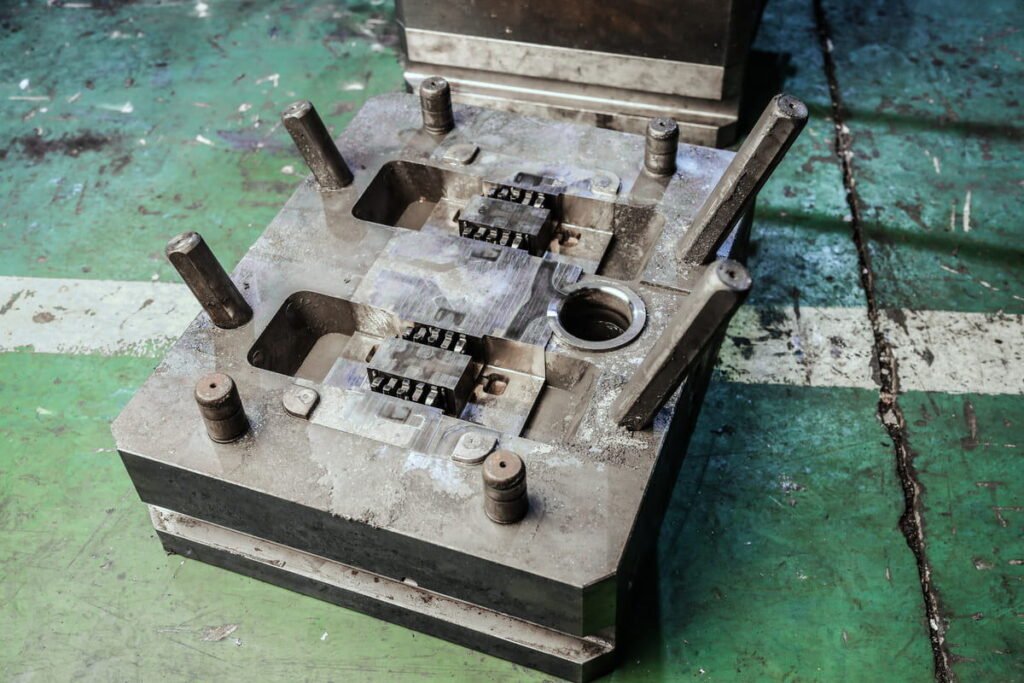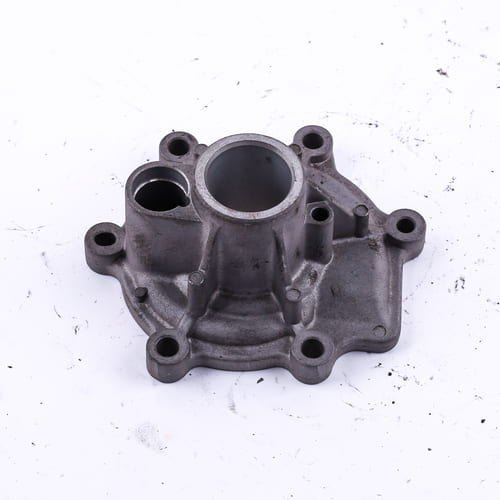What is iron casting?
Cast steel is an alloy consisting of iron and carbon. The amount of carbon contained in the iron is not less than 2.14%. The carbon may be cementite or graphite. Cast steel contains some impurities such as Si, Mn, S, P and alloying substances. The negative properties of cast steel include brittleness.
There are several types of cast steel, which differ in chemical composition. Let’s consider them.

White cast steel
White cast steel is characterized by a light fracture color. The chemical composition of white cast steel is as follows: perlite, ledeburite, cementite.
Gray cast iron
The fracture color of this type of ductile iron is grey. Gray cast steel is an alloy consisting of elements such as iron, silicon, carbon. The composition of molten metal in the metal casting process contains impurities Mn, P, S. Carbon in the composition of this cast steel is presented in the form of graphite.
Ductile iron
Ductile iron is a derivative of white ductile iron obtained by prolonged annealing. The essence of this process is the formation of graphite in the form of flakes. The basis of the chemical composition of ductile iron is ferrite or perlite.
It contains spheroidal graphite. Its formation is associated with the process of crystallization. Ductile cast steel is called because its base is not much weakened compared to ductile iron, which contains lamellar graphite.
Half cast iron
The chemical composition of half ductile iron is a combination of such components as perlite, ledeburite, lamellar graphite. Carbon is presented in the form of cementite.

There are other classifications of types of ductile iron.
According to the carbon content, cast steel is:
• Hypereutectic
• Eutectic
• Hypereutectic
Gray iron is an iron-carbon alloy with a carbon content of more than 2.14%. It may also contain permanent impurities, and sometimes alloying components. Its mechanical properties depend on the structure and mainly on the form in which the carbon is found, and the main structural constituents are cementite or graphite and the decomposition products of austenite.\
It depends on the cooling rate can be martensite, troostite, sorbitol, perlite, and ferrite. The introduction of various alloying elements makes it possible to control the graphitization process and adjust the properties of gray iron in different ways.
Cast iron: a brief reference
Steel and gray iron are common technical terms for alloys of iron and carbon. The carbon content in cast steel is from 2.14% to 6.67%, the rest is iron, impurities, and alloying additives.
Carbon can be in the form of graphite or cementite (Fe 3 C – cementite, iron carbide) inclusions. The main impurities are silicon, sulfur, manganese, and phosphorus. Gray iron is used in foundry production and is also used as a raw material for steel smelting.
Features and classification of cast irons
The characteristics of the alloy are formed at the production stage. Depending on the parameters of the eutectic transformation, gray irons are gray (carbon in the form of graphite), white (carbon in the form of cementite), and half cast irons.
The size and configuration of graphite inclusions determine the grades of cast iron and their application. According to the shape of graphite inclusions, they are subdivided into gray irons with lamellar, spherical, vermicular, and flaky graphite, and according to the type of metal base – into pearlite, pearlite-ferritic, ferritic, austenitic, bainitic and martensitic. In addition to carbon, cast iron contains:
- sulfur – 0.02-0.2%;
- silicon – 0.5-3.6%;
- manganese – 0.2-1.5%;
- phosphorus – 0.04-1.5%.

Depending on the content of additional additives, gray irons are divided into unalloyed and alloyed. Alloyed alloys include alloys in which elements such as nickel, chromium, copper, aluminum, titanium, vanadium, tungsten, molybdenum, etc. are added to create specific properties.
In turn, alloyed cast irons are classified according to the main alloying into chromium, aluminum, nickel, etc.
Main Differences Between Steel and Gray iron
The main difference between cast iron and steel is the proportion of carbon in their composition (in steel it ranges from 0.025% to 2.14%, in gray iron it is over 2.14%) and the content of impurities (there are more of them in cast iron).

This forms the melting point of the alloys. If for gray irons it is 1150-1250 degrees, then for steels this figure reaches 1500 ° C.
In appearance, the steel will be lighter, and gray cast irons will have a dark and matte tint. Steel is easier to weld and forge, but worse for casting. A gray iron product has a slightly higher thermal conductivity than a steel product.
Types of cast irons and their application
Pig iron
This alloy is smelted in blast furnaces and is intended for further processing into steel or castings. Can be used in both liquid and solid state. In pig iron, the content of silicon, manganese, sulfur, and phosphorus is strictly controlled.
The main standard that specifies the requirements for these products is GOST 805. Depending on the silicon content and purpose, the following types of pig iron are distinguished:
- Pig iron for steelmaking grades P1, P2;
- pig iron for foundry production grades PL1, PL2;
- conversion phosphorous gray iron PF1, PF2, PF3;
- conversion high-quality cast iron PVK1, PVK2, PVK3.
White cast iron
In it, all carbon is in the form of cementite. The structure is formed at a high cooling rate. A distinctive feature of this type of cast iron is a white tint at the fracture site, as well as high brittleness and hardness.
The product is practically not amenable to machining with a cutting tool. These alloys are used for the production of cast wear-wear resistance parts (grinding balls, screw blades, shot blast turbine blades, rolling rolls), as well as the basis for the production of malleable carbon steel varieties.
The wear corrosion resistance of carbon steel is increased by alloying with molybdenum, nickel, manganese, and other elements.
Gray cast iron
In gray carbon steels, carbon is represented by lamellar graphite. It is in free form, due to which the fracture has a characteristic gray color. Such an alloy is relatively well-machined and has relatively low strength and low tensile ductility.
At the same time, due to the presence of lamellar graphite, alloy steels have good antifriction and damping properties, and low sensitivity to stress concentrators. The internal structure is formed at low cooling rates.

Gray carbon steel has good fluidity and is less prone to the formation of shrinkage defects compared to other types of cast iron, therefore it is widely used for the manufacture of complex-shaped castings with wall thicknesses up to 500 mm.
The marking is defined by GOST 1412 and denotes a list of grades from SCH 10 to SCH 35.
- Letters SCH – gray carbon steel;
- numbers – information about the tensile strength (MPa / 10)
Ductile (modified) carbon steel
The peculiarity of this alloy, obtained by adding pure magnesium (Mg), its compounds, or other modifiers-spheroidizers (cerium, yttrium, etc.) to the carbon steel melt, is that the graphite in such cast iron has a spherical shape. The amount of the modifying component, the same magnesium, is 0.02–0.08%.
The properties of nodular carbon steel are determined mainly by the metal base (in contrast to alloy steels with lamellar graphite inclusions).
Such a high-strength alloy is used in the production of wear-wear resistance parts for critical purposes that can withstand large static, cyclic, and impact loads under wear conditions, including in aggressive environments and at high temperatures.
Ductile iron and its marking
An annealing product of white carbon steel billets, having in its structure graphite in the form of flakes (“annealing carbon”). This gives the alloy high strength and increased ductility, uniform distribution of properties, good machinability, and an almost complete absence of internal stresses in castings.
Due to these properties, malleable cast iron has found application in the production of critical products – parts and elements operating under vibration and shock loads.
Corrosion Resistance Cast Iron Parts
Depending on the chemical composition of the carbon steel and the annealing modes, it is possible to obtain a different base – ferritic, pearlitic, or ferritic-pearlitic. There are also two varieties of malleable metal – black-hearted and white-hearted.
Capaciously and accurately characterize ductile iron marking that contains not only its designation (KCh), but also the main mechanical properties – the minimum tensile strength and relative, and the relative elongation is not less than 8%.
Special cast irons
There are grades of alloys with special characteristics, which are achieved by alloying, using a special annealing and cooling technology. These carbon steels include:
- heat-wear resistance;
- corrosion wear resistance;
- artistic;
- anti-friction and wear-wear resistance;
- carbon steels with special electromagnetic properties;
- ferroalloys and others.
Specifications for alloyed special cast irons are regulated by the standards DSTU 8851, GOST 7769, ISO 2892, and others. They specify what cast iron is made of for various special applications, what mechanical properties it should have, and how it should be marked.
How do special impurities affect the structure of cast iron?
In the production of individual alloys, the addition of special additives to cast iron changes its composition and properties.
- Silicon is the most important alloying element in cast iron, which together with carbon influences the structure and properties. Silicon has a positive effect on the release of graphite and improves the casting characteristics of the alloy.
- Sulfur reduces the ability of liquid iron to fill molds, reduces its mechanical properties, and imparts red brittleness.

- Manganese has a negative effect on casting properties, and counteracts graphitization, but increases hardness and strength.
- Phosphorus is necessary for the manufacture of cast iron castings of complex shapes, including thin-walled ones, since it contributes to an increase in the fluidity of the alloy.
- Other alloying additives introduced at the stage of material smelting also make it possible to achieve specific properties.
This results in a modified characteristic of cast iron with improved wear or heat corrosion resistance, corrosion resistance, or electrical conductivity.
Advantages and disadvantages
The first discovered rough iron castings date back to the middle of the 14th century. Since then, technology has changed significantly, and the use of cast iron has expanded. Objectively evaluating this product of ferrous metallurgy, it is necessary to name both its positive and negative sides.
Undeniable advantages
First of all, it is environmental friendliness and excellent hygienic qualities. The same cast-iron cookware is not destroyed in acid-alkaline solutions, it washes well and warms up, keeping the accumulated heat for a long time.
It should be noted the durability and a wide range of products, cost-effectiveness, and a relatively simple process for the production of cast iron products.
By varying the state of carbon in the alloy, white or molten iron can be obtained. A wide range of applications is due to easy processing (forging), high heat transfer, and strength.
Disadvantages of cast iron as a material
The weakest sides of the alloys are brittleness and susceptibility to rust even with short-term interaction with water. In addition, cast iron products are characterized by a large weight and a specific set of physical and mechanical characteristics that require special conditions for their transportation, assembly, and maintenance.
Why Castingod?
If you are interested in high-quality rolled metal from certified materials, please contact us.








